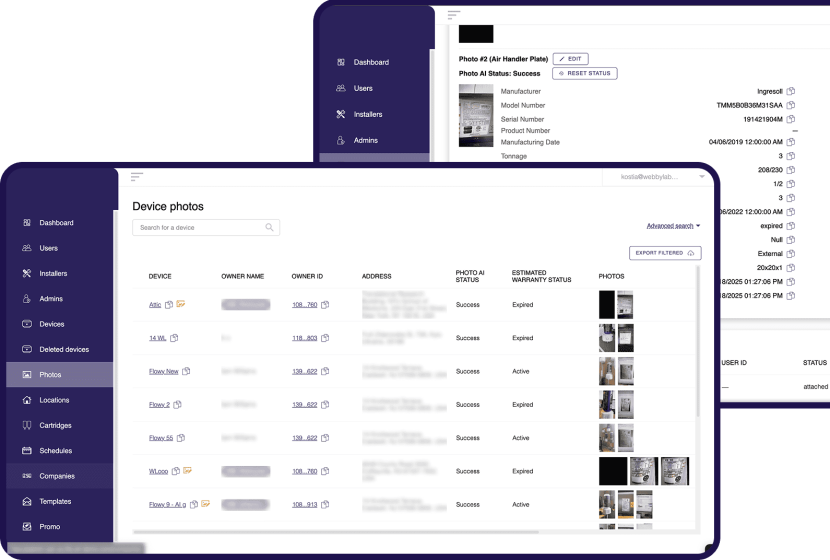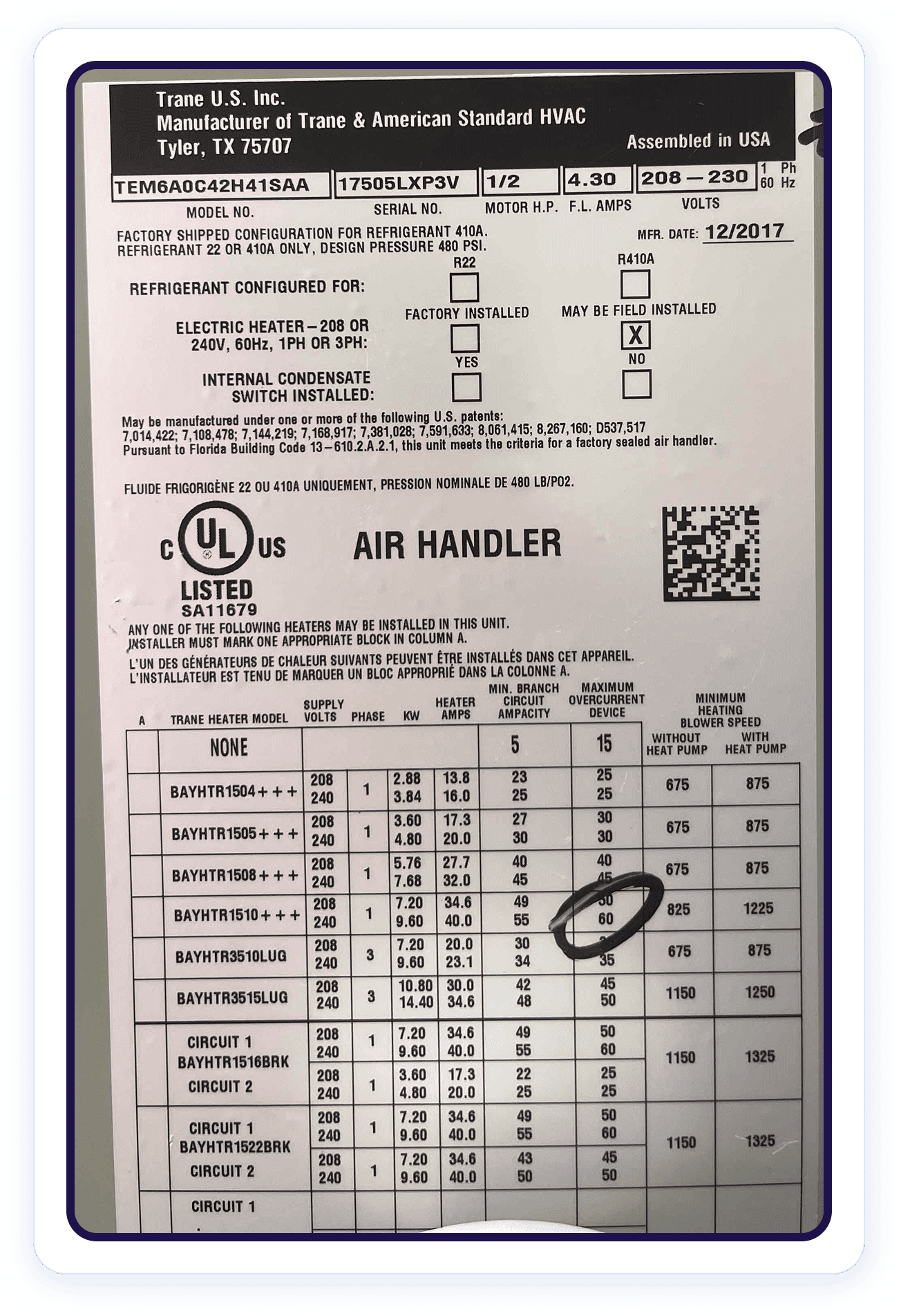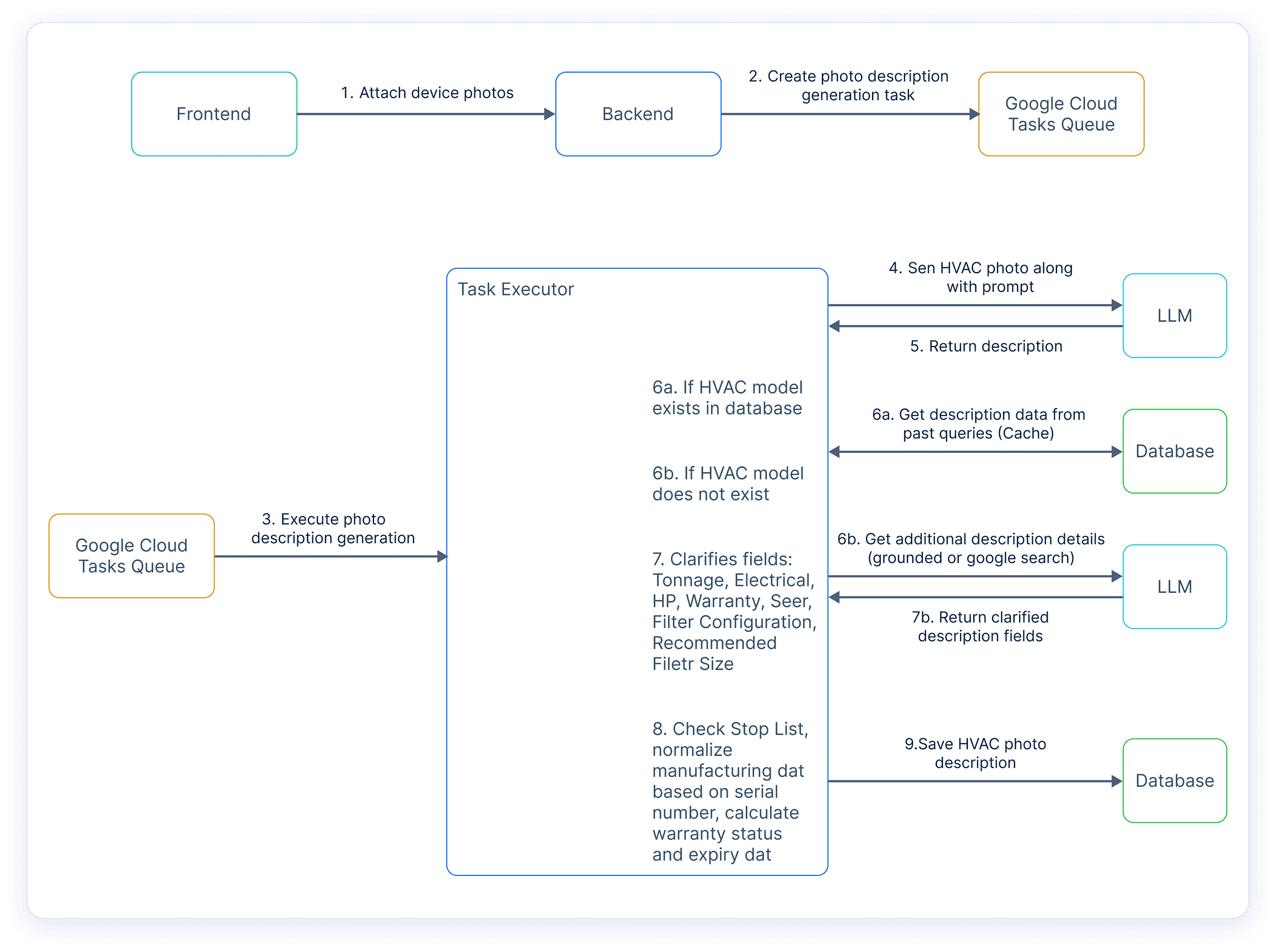The brief
Our client, an American startup, has developed an IoT HVAC solution that combines smart cleaning devices with web and mobile applications. The devices automatically clean A/C drain lines of bacteria and blockages, while the apps let B2C and B2B users easily install, monitor, and manage the devices, as well as order and replace cleaning cartridges.
As the product began expanding into the B2B market, our client noticed another opportunity. Professional HVAC integrators who install and maintain heating and cooling systems often face one common information gap. When arriving at a site, they rarely know what exact models of air handlers they will be dealing with, their warranty conditions, or service lifespans. This lack of information makes planning preventive maintenance more difficult, increases costs, and downtime.
To address this, our client proposed a new feature: let users and integrators take a photo of the air handler label during device setup. The platform would then recognize the model and extract key specifications, warranty information, and maintenance data. With this feature, predictive maintenance for HVAC systems would become significantly easier.
Challenge
Building the air handler brand identification feature was far from straightforward.
HVAC equipment comes from over 15 major manufacturers and many lesser-known ones, each with dozens of models. Therefore, we decided that creating a comprehensive reference database manually wasn’t sustainable. Instead, we chose AI as the only viable path forward.
The challenge was to design an air handler model and brand identification AI solution that could:
- Accept user-uploaded photos of HVAC air handler labels.
- Identify the air handler brand and model as a starting point.
- Extract a broader set of technical and service-related details, including:
- Brand
- Model number
- Serial number
- Product number
- Manufacturing date
- Tonnage
- Electrical details
- Horsepower
- SEER rating
- Warranty status and expiry date
- Filter configuration and recommended size
Our goal for HVAC equipment data extraction from images was to get as much useful data as possible from every air handler photo. To do this while keeping costs down, we decided to develop an algorithm that captures all the data and significantly reduces analysis expenses.
Solution
To tackle the challenges and meet the set goals, we developed a multi-layered label recognition algorithm powered by AI. Here is how it works:
- Photo submission. End users upload a photo of the air handler nameplate through the mobile or web app.
- Task creation. The backend creates a task for photo description generation and places it in the Google Cloud Tasks Queue.
- Asynchronous execution. Tasks are handled one by one, which ensures stable performance and optimized resource usage.
- Initial analysis. The system uses a large language model (LLM) for the initial AI photo analysis for B2B HVAC integrators. LLM extracts such key details as brand, model number, serial number, and more.
- Description return. The system returns the description with data points extracted from the photo.
- Further analysis. The received description is analyzed to see if it contains the necessary data, primarily the brand and model.
- If the air handler model has already been processed, the system pulls details from the cache instead of re-analyzing the photo. This makes recognition faster and reduces costs for models previously identified and stored in the database.
- If it’s a new model, the system enriches the data using either Vertex AI grounding for HVAC data extraction (our curated library of manuals, PDFs, and photos) or Google Search grounding for additional validation.
- Data clarification. The system returns a JSON file with all the data fields required, or at least the most critical ones.
- Data normalization. The system cleans, standardizes, and validates all data before saving it in the database.
- Invalid or duplicate photos (e.g., of our own device) are filtered out.
- Manufacturer names are standardized.
- Manufacturing date is determined either from the label itself or by decoding the serial number with brand-specific rules (e.g., Trane’s serial code system).
- Warranty status and estimated expiry date are calculated, even if the manufacturing date isn’t explicitly listed.
- Data persistence. All structured HVAC metadata is stored in the database of our IoT-enabled HVAC monitoring platform.
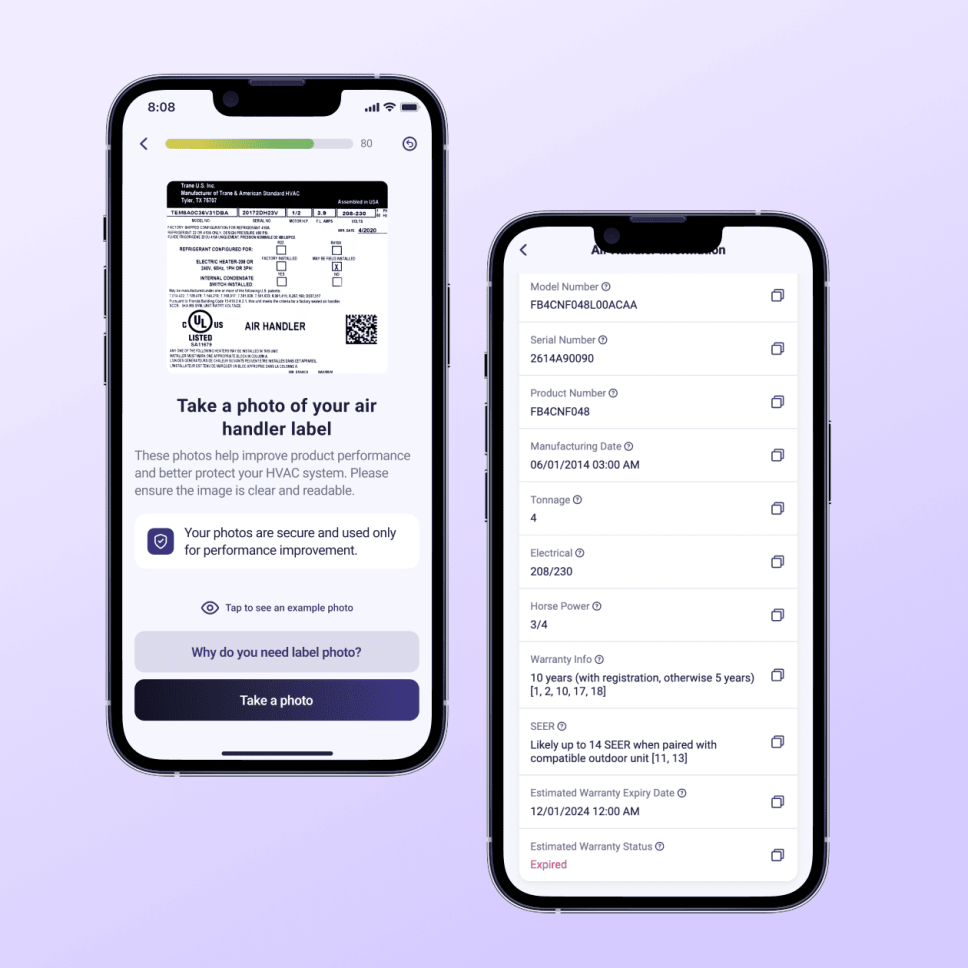
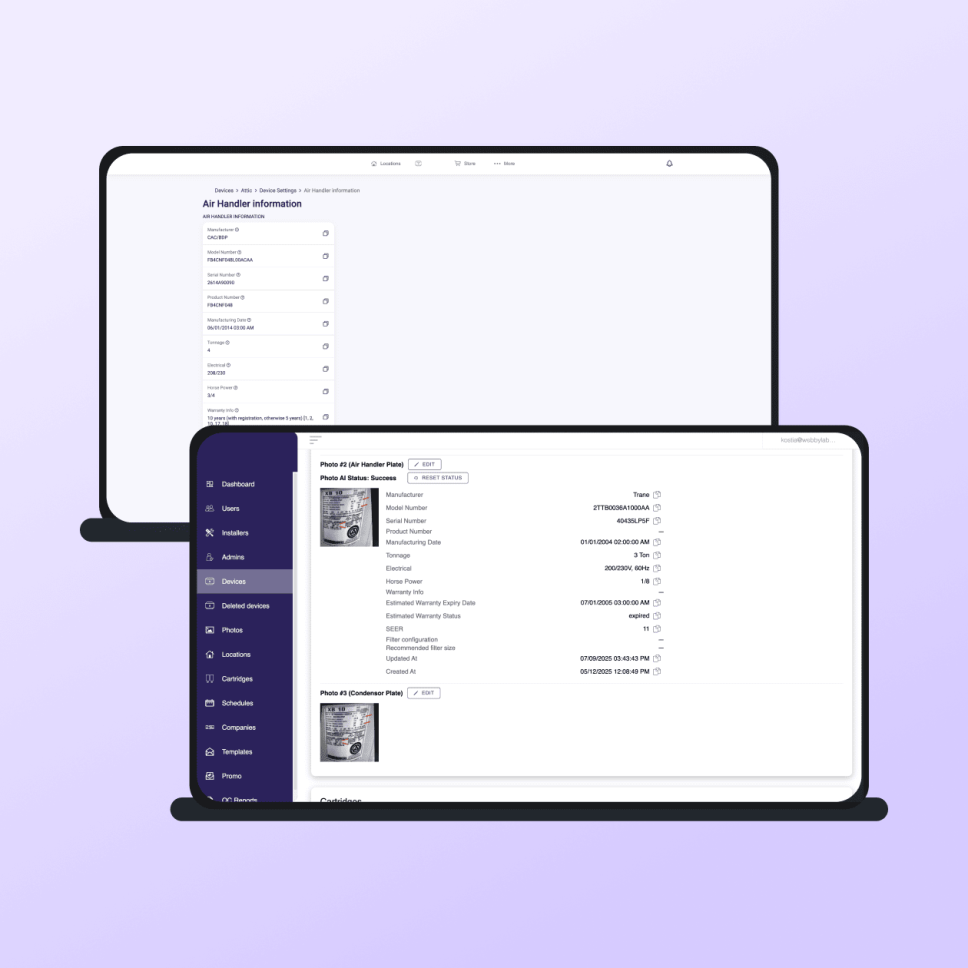
Results
The AI-powered HVAC label recognition solution we delivered successfully transformed our client’s business.
- For B2B integrators, it provides immediate, actionable intelligence on HVAC units before arriving on-site.
- For end users, it offers clarity about their HVAC systems, whether it’s HVAC warranty status detection or recommended maintenance.
- For our client, it opens a new revenue stream, a competitive edge, and cost optimization.
- This is the lowest-cost option. We keep a cache (i.e. a fast lookup table) of previously recognized models.
- If the incoming request matches something already stored, we can immediately return the answer without invoking heavier AI or search services.
- Because it bypasses expensive compute or search, this mode is extremely cheap and fast.
- If the cache doesn’t contain the needed answer, we “ground” the request using Vertex AI (Google’s managed AI platform) and our proprietary knowledge base (a “data store”).
- “Grounding” here means: we fetch relevant documents or facts from our internal database (or vector index) and feed them as context to the large language model (LLM) so it can make a more informed, accurate decision.
- This approach gives higher accuracy than cache-only, while remaining far cheaper than doing a full external search.
- Using Vertex AI this way is supported by Google’s infrastructure for retrieval-augmented generation (RAG) or similar mechanisms.
- This is the “fallback” highest-cost option, used when neither cache nor internal knowledge yields a confident result.
- In this mode, we issue live queries to Google Search to pull up relevant web pages and external information. Then we feed that retrieved context to the LLM to derive the model number.
- Because invoking a general web search and processing its results is more expensive (and slower) than using internal data, this is the priciest mode.
- Google’s policies indicate a cost of about $35 per 1,000 grounding (search) requests (i.e. ~$0.035 per request) when using their
google_searchtool. (Google AI for Developers)
- Latency: Cache lookup is nearly instantaneous, while external search takes longer.
- Cost: We avoid paying for web search when possible — only use it when needed.
- Accuracy / coverage: The internal knowledge base (via Vertex AI) handles most “normal” or known model numbers. But when a rare or new model appears, Google Search grounding can help cover gaps.
- Scalability: This layered scheme means the system scales cost-efficiently — common queries hit the cheap layer, and only edge cases incur higher cost.
- Cache: a stored set of precomputed answers (or partial results). If a new request matches something in the cache, we can reuse the previous answer rather than recomputing.
- Grounding: giving the LLM external context or evidence (from internal or external sources) so its outputs are anchored to real data, reducing hallucinations.
- Vertex AI: Google Cloud’s managed AI/ML platform, offering model serving, retrieval, embedding indexing, and “grounding” capabilities using your own data store.
- Google Search grounding: using live web search (via Google’s APIs or search tool) as the source of external context when internal knowledge is insufficient.
In particular, our air handler model recognition pipeline achieves a practical balance between cost and accuracy by using a three-tier strategy. For queries that match entries in our cache, we use cache retrieval at $0.093–$0.279 per 1k of requests. If that fails, we fall back to Vertex AI grounding, where we query our internal knowledge base and feed it to the model, at $2.593–$7.779 per 1k of requests. Only for hard or novel cases do we escalate to Google Search grounding, which invokes web search and costs $35.093–$105.279 per 1k of requests. This layered approach lets us deliver high accuracy when needed but keeps costs low most of the time, ensuring efficient, scalable performance.

